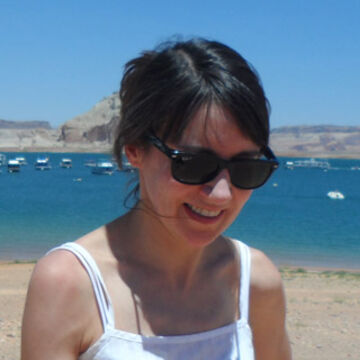

Margaret MacNamidhe
Associate Professor, Adjunct
Contact
Bio
Education: BFA, 1987, National College of Art and Design, Dublin; MAAH coursework, 1993, SAIC; MA, 1996, and PhD, 2002, Art History, Johns Hopkins University, Baltimore. Books: Delacroix and His Forgotten World: The Lost Origins of Romantic Painting (I.B. Tauris, London, 2015) Reviews Frédérique Baumgartner, CAA, reviewed March 12, 2018, Katharine Rovanpera, Art Libraries Review, reviewed March 2016; Katie Hornstein, H-France, reviewed October 2016, Catherine Marshall, Dublin Review of Books, reviewed June 2015. Press: Launch, National Gallery of Ireland, May 2015; Conversation with Anne Leonard, Seminary Bookstore, October 2015; Interview with Fionn Davenport, "Inside Culture," RTE Radio 1, May 2 2016. Articles: “Rose-Period Picasso: Drawing, Effort, and Habit in Modernism,” non-site 16 (Spring 2015), unpag. “Diderot’s Touch,” The Contemporary Querrelle Between the Ancients and the Moderns, Benjamin Binstock and Mary Stieber, eds., Ashgate Publishing (forthcoming) “Action-inaction: l’anti-spectaculaire chez Delacroix,” Bulletin de la Société des Amis du Musée Eugène Delacroix 7 (2009): 3-10 “Etienne-Jean Delécluze’s Response to Eugène Delacroix’s Scenes from the Massacres at Chios (1824),” The Art Bulletin 89 (March 2007): 63-81 “Introduction,” in Stephen Bann, Ways Around Modernism, Routledge, 2006 “Sigalon’s Poison,” in The Enduring Instant, Time and the Spectator in the Visual Arts, Antoinette Roesler-Friedenthal and Johannes Nathan, eds. (Berlin: Gebrüder Mann, 2003): 81-91. Book reviews: S.Hollis Clayson, Illuminated Paris: Painting and Lighting in the Belle Époque, Nineteenth-Century Studies Worldwide (Feb. 2020); Niamh O"Sullivan, Aloysius O'Kelly: Art, Empire, Nation, Nineteenth-Century Studies Worldwide (Oct. 2016); Susan Waller, The Invention of the Model: Artists and Models in Paris, 1830-1870, French Studies 61 (Jul. 2007): 389-390, Daniel et Marie-Jeanne Ternois, eds. Lettres d’Ingres à Gilibert. French Studies 61 (Jan. 2007): 104-105, Marie-Claude Chaudonneret, ed. Adolphe Thiers: critique d’art, Salons de 1822 et de 1824, French Studies 60 (Apr. 2006): 275-276, Richard R. Brettell, Impression: Painting Quickly in France 1860-1890. Nineteenth-Century French Studies 31 (Spring 2003): 352-354. Selected publications: “Practice, Research, and the Visual Arts,” introductory essay to my edited collection of essays on practice, Journal of Visual Art Practice 22 (December 2024); “History Before Art History: The Flawed Resurrectionist Postnational in Nineteenth-Century France,” in Ian McLean and Charles Green, eds. Postnational Art Histories: What is Postnational Art History? (Melbourne: CoVA x Perimeter, 2023), 93-106. Current project:The Desk-Bound Hand: Drawing in Modernism and After (ms under review, University of Chicago Press). Awards: Jean Goldman Literary Lion Research Award (May 2019); Lorado Taft Award, University of Illinois, 2011, Humanities Institute of Ireland, 2009, Irish Research Council for the Humanities and Social Sciences, 2004–6, Israel Rosen Prize, 1996, Johns Hopkins Fellowships, 1993-95, Fulbright Scholarship, 1991–92, International Student Scholarship, SAIC, 1992, Ireland Fund Bursary, 1991–93, Greek Government Scholarship, 1989–90, Tyrone Guthrie Centre, Ireland, 1988, Norwegian Government Scholarship, 1988. Exhibitions (as artist): Solo Exhibition, Mount Street Gallery, Dublin 1989; Art of the State, Dublin Castle; Institute for European Affairs, Louvain, Belgium, 1999, Arís, Temple Bar Gallery, Dublin, 1993, Contemporary Irish Artists, Venté Museum, Tokyo Drawings by Five Artists, Rubicon Gallery, Dublin, 1991, Art Inc., Guinness Hop Store, Dublin; Greek and International Artists, Athens, 1989, Germinations 5, Musée d’Art contemporain, Lyon; Frauenmuseum, Bonn, De Beyerd, Breda, The Netherlands, 1989-1990, Guinness Peat Aviation Awards, Trinity College, Dublin. Collections: Government of Ireland (National Concert Hall; on permanent exhibition); Fujita Vente Museum, Tokyo; Joseph Masheck, New York. Selected conferences: Modernist Studies Association 2024; Samuel H. Kress Seminar in European Art, Newberry Library, 2023; CAA 2020; CAA 2018 (Chair of Panel “Theorizing the Gap: Studio Knowledge and Art History") 2015 (Chair of Panel, “The Studio History of Art”), CAA 2014; CAA 2011; UIUC 2010; Humanities Institute of Ireland 2009; CAA 2008; 2007 Fitzwilliam College, Cambridge; 2006 University of Bristol; 2005 International Association of Word-&-Image Studies; 2005 University of Leeds; 2005 CAA; 2005 AAH; 2003 University of Notre Dame, London Centre; 2003 University of Sydney; 2003 IAWIS; CAA 2000; Thirtieth International Congress of the History of Art, London.
Teaching
Thesis Advisees
Riley Gunderson, MAAH candidate (current advisee; anticipated graduation 2025): provisional thesis title, "Banner: noun, verb, adjective, form, medium."
Elise Cabral (MA 2020), “László Moholy-Nagy and the Plasticity of Material”
Elle Tompkins (MA 2019), “The Art of Eating: An Investigation of Contemporary Artists and Designers who Critically Analyze Industrial Food, Marking their Parallels to Gastronomic Social Movements”
Kat Buckley (MA 2018), “Threading through the Interwar: Nomadism, Tapestry, and the Rediscovery of Marie Cuttoli”
Anastacia Davis Bersch (MAVCS, 2017), “Joan of Marquette: Materializing a Religious Ecology”
Lillian Elliott (MA 2015), “Great Scott! Picturing the Past through the Waverley Novels”
Jacqueline Kenyon (MS, Historic Preservation, 2014), “Anna Hyatt Huntington, Laura Gardin Fraser, and Sylvia Shaw Judson: A Comparison of Careers and
Study of Cultural Milieu in Historic Sculpture”
Professional Service
CAA Reviewer, May 2019 (Panels, Papers, Poster Sessions), Annual Conference (Chicago, February 2018)
BAAH Thesis Assessment Panel, May 2018 (with Rhoda Rosen and Annie Bourneuf)
MAAH Workshop Panel, March 2017 (with Daniel Quiles and Annie Bourneuf)
Courses taught, 5000:
“History of Art History” (x 7)
“Histories of Skilling and De-Skilling in Art Schools” (x4)
“Art, Criticism, and Our Modern Life, 1789-1920” (x5)
“Why Divide Up Picasso?” (x3)
4000:
“The Blue Flower: European Symbolism, 1857-1914”
Art History Methods/Professional Practice/ProSeminar (x2)
“Painting in France, 1848-71” (x2)
“Impressionism and PostImpressionism” (x 6)
Diderot and Baudelaire (independent study)
Current Interests
I’m researching histories of compulsory childhood education worldwide. What interests me are the epistemologies of different systems and their emphases on handwriting and drawing.